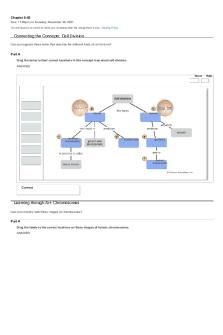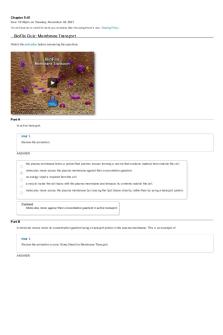Chapter 8-01 - Pearson - Homework PDF

| Title | Chapter 8-01 - Pearson - Homework |
|---|---|
| Course | Biological Principles For Non-Majors |
| Institution | Broward College |
| Pages | 15 |
| File Size | 813 KB |
| File Type | |
| Total Downloads | 36 |
| Total Views | 156 |
Summary
Pearson - Homework...
Description
Chapter 8-01 Due: 11:59pm on Tuesday, November 30, 2021 You will receive no credit for items you complete after the assignment is due. Grading Policy
Learning through Art: Chromosome Packing Can you correctly label the structures in this diagram that summarizes chromosome packing?
Part A Drag each label to its proper place in the diagram. ANSWER: Reset
chromosome nucleosome
supercoil
histone
chromatin
Correct
BioFlix Activity: Mitosis -- The Cell Cycle Can you label the phases of the cell cycle? To review a crucial phase of the cell cycle, watch this BioFlix animation: Mitosis.
Part A - The cell cycle Drag the pink labels onto the pink targets to identify the two main phases of the cell cycle. Then drag the blue labels onto the blue targets to identify the key stages that occur during those phases. ANSWER:
Help
Reset
phase
Interphase
phase
phase
Mitotic (
Cytokinesis
Mitosis
Correct
Activity: The Cell Cycle
Click here to complete this activity. Then answer the questions.
Part A Which of these phases encompasses all of the stages of mitosis?
ANSWER:
) phase
Help
A E D C B
Correct This is mitosis.
Part B During _____ both the contents of the nucleus and the cytoplasm are divided. ANSWER:
G2 G1 mitosis S the mitotic phase
Correct The mitotic phase encompasses both mitosis and cytokinesis.
Part C During _____ the cell grows and replicates both its organelles and its chromosomes. ANSWER:
G1 mitosis S cytokinesis interphase
Correct These are the events of interphase.
BioFlix Quiz: Mitosis Watch the animation before answering the questions.
Part A What must happen before a cell can begin mitosis?
Hint 1. Recall what happened during the interphase segment of the animation.
ANSWER:
The nuclear envelope must break up. The nucleus must divide in two. A mitotic spindle must form. The chromosomes must be duplicated. The sister chromatids must be separated.
Correct Before mitosis can begin, the chromosomes, or genetic material, must be copied, which occurs during interphase.
Part B The centrosomes move away from each other and the nuclear envelope breaks up during which phase of mitosis?
Hint 1. Recall from the animation that the centrosomes move away from each other and the nuclear envelope breaks up after chromosome duplication but before the sister chromatids line up in the middle of the cell.
ANSWER:
Interphase Prophase Telophase Metaphase Anaphase
Correct Prophase is the first phase of mitosis, when the centrosomes begin moving toward opposite poles and the nuclear envelope breaks up.
Part C The chromosomes line up in the center of the cell during which phase of mitosis?
Hint 1. Recall that during the animation, the chromosomes lined up in the center of the cell after the nuclear envelope broke up, but before the sister chromatids were separated.
ANSWER:
Telophase Anaphase Prophase Metaphase Interphase
Correct Metaphase occurs in the middle of mitosis, when the chromosomes line up in the middle of the cell.
Part D The sister chromatids separate and begin moving toward opposite poles of the cell during which phase of mitosis?
Hint 1. Recall from the animation that sister chromatids separated and started to move toward opposite poles after they had lined up in the center of the cell.
ANSWER:
Anaphase Metaphase Telophase Prophase Interphase
Correct Sister chromatids separate and start their migration toward opposite poles during anaphase.
Part E The chromosomes arrive at the poles and nuclear envelopes form during which phase of mitosis?
Hint 1. Recall that during the animation, the chromosomes arrived at the poles and nuclear envelopes formed during the last phase of mitosis.
ANSWER:
Interphase Telophase Anaphase Metaphase Prophase
Correct Telophase is the final phase of mitosis, when the chromosomes have arrived at the poles and the nuclear envelopes of the two new cells form.
Part F At the end of the mitotic (M) phase, the cytoplasm divides in a process called _________________.
Hint 1. During the animation, what process occurred in conjunction with the final phase of mitosis?
ANSWER:
replication telophase meiosis cytokinesis condensation
Correct Cytokinesis is the division of the cytoplasm that occurs in conjunction with telophase, the last phase in mitosis.
BioFlix Activity: Mitosis -- Events of Mitosis Can you label the events and stages of mitosis? To review the process of mitosis, watch this BioFlix animation: Mitosis.
Part A - Events of mitosis Drag the pink labels onto the pink targets to identify key events in mitosis. Then drag the blue labels onto the blue targets to identify the stages of mitosis. ANSWER:
Reset
Mitotic spindle forming
Interphase
Prophase
Sister chromatids centered
Metaphase
Chromosomes separating
Anaphase
Help
Nuclear envelopes forming
Telophase and cytokenesis
Correct
MP3 Tutor Session: Mitosis Click the image below to listen to the MP3 Tutor Session. You can also download the MP3 or view the text of the tutor session to read while you are listening. Estimated time: 10 minutes, 35 seconds. After you have listened to the tutor session, answer the questions.
Part A In sexually reproducing multicellular organisms, the main functions of mitosis are _____. Check all that apply. ANSWER:
reproduction (production of gametes) tissue repair/replacement of damaged cells growth and development
Correct
Part B Which events occur during prophase? Check all that apply. ANSWER:
Chromosomes condense and are attached to spindle fibers. The nuclear envelope breaks down. The sister chromatids break apart and begin to separate. Chromosomes are replicated.
Correct
Part C Cytokinesis _____. ANSWER:
duplicates the chromosomes, setting the stage for cell division produces two new nuclear envelopes finishes mitosis by dividing the cytoplasm and organelles of the original parent cell into two separate daughter cells lines up the paired chromatids along the center of the cell in preparation for anaphase
Correct
Part D During _____, the cell carries out its normal functions and the chromosomes are thinly spread out throughout the nucleus. ANSWER:
anaphase interphase prophase metaphase telophase
Correct
Part E Looking through a light microscope at a dividing cell, you see two separate groups of chromosomes on opposite ends of the cell. New nuclear envelopes are taking shape around each group. The chromosomes then begin to disappear as they unwind. You arewitnessing _____. ANSWER:
metaphase telophase prophase anaphase
Correct
BioFlix Activity: Mitosis -- Stages of the Cell Cycle Can you label the stages of the cell cycle? To review the stages, watch this BioFlix animation: Mitosis.
Part A - Stages of the cell cycle Drag the labels onto the diagram to identify the stages of the cell cycle. ANSWER:
Reset
Most of the cell's life is spent in interphase, when growth occurs. Cells that are about to divide replicate their DNA.
In prophase microtubules form the mitotic spindle, and the nuclear envelope breaks up.
Correct
Activity: Mitosis and Cytokinesis Animation
At metaphase, the mitotic spindle is fully formed and chromosomes are lined up in the center of the cell.
In anaphase, sister chromatids separate and become full-fledged chromosomes that move to opposite poles.
In telophase chromosomes become less condensed and new nuclear envelopes form. In cytokinesis the cytoplasm divides.
Help
Click here to complete this activity. Then answer the questions.
Part A Nucleoli are present during _____. ANSWER:
prometaphase metaphase prophase anaphase interphase
Correct Nucleoli are present during interphase.
Part B Cytokinesis often, but not always, accompanies _____. ANSWER:
interphase prometaphase metaphase anaphase telophase
Correct Cytokinesis often, but not always, accompanies telophase.
Part C Chromosomes become visible during _____. ANSWER:
prometaphase prophase anaphase metaphase interphase
Correct During prophase, the chromatin fibers become discrete chromosomes.
Part D Centromeres divide and sister chromatids become full-fledged chromosomes during _____. ANSWER:
metaphase interphase prometaphase anaphase telophase
Correct During anaphase, sister chromatids separate and migrate to opposite poles.
Part E Spindle fibers attach to kinetochores during _____. ANSWER:
interphase anaphase prometaphase metaphase telophase
Correct Attachment of spindle fibers to kinetochores is one of the events of prometaphase.
Part F During prophase a homologous pair of chromosomes consists of _____. ANSWER:
two chromosomes and four chromatids one chromosome and two chromatids two chromosomes and two chromatids four chromosomes and two chromatids one chromosome and four chromatids
Correct At this point each of the chromosomes consists of two chromatids.
Building Vocabulary: Cancer Can you match the terms associated with cancer to their descriptions?
Part A Drag the terms on the left to the appropriate blanks on the right to complete the sentences. ANSWER:
Reset
Help
1. A benign tumor is a lump of abnormal cells that, although growing out of control, remains at its original site.
2. A malignant tumor is an abnormally growing mass of cells that is actively spreading through the body.
3. Metastasis is the spread of cancer cells from their site of origin to other sites in the body.
4. An individual with a malignant tumor is said to have cancer .
Correct
Everyday Biology: Are Fruit Flies the Key in the Fight Against Cancer? Watch the Everyday Biology video, read the accompanying essay, and then answer the questions below.
Terri Clark, the country musician who lost her mom to cancer, described it well: “When someone has cancer, the whole family and everyone who loves them does, too.” Sooner or later, nearly all of us will know someone with cancer. Unfortunately, there is no cure for cancer today, and there may never be a cure. The difficulty lies in the fact that there are so many different types and causes of cancer, so there may never be a single cure. Cancer is a genetic disease, not because it is inherited, but because it is always the result of mutations in DNA. And because the genetic mutations that cause cancer vary from patient to patient, individualized treatments hold the most promise for people with cancer. As Dr. Ross Cagan describes in the video, personalized care requires creating a living model of the tumor on which drugs can be tested. What Dr. Cagan has done is created a model of the tumor that resides in a fruit fly – what he calls a “personalized Drosophila avatar.” This is certainly not the first time we have used other organisms to test the safety and effectiveness of drugs. The Ames test (named after the biochemist Bruce Ames) has been used since the early 1970s to determine the potential for various chemicals to cause mutations using a petri dish full of bacteria. The Ames test is an easy way to screen thousands of chemicals quickly and cheaply. Thousands of chemicals, from pesticides to food additives to a flame retardant in kids’ pajamas have been shown to be mutagenic using the Ames test. Bacteria are not people, but we often use animal models to test the safety and effectiveness of drugs. Using animals, however, has its own set of problems. Many people are concerned about animal rights, particularly when mammals are used as test subjects. Animal testing can be painful and expensive – and time consuming – an important consideration given the time-sensitive nature of treatment. That’s the beauty of Dr. Cagan’s fruit fly models. Fruit flies are insects, and few people worry about “insect rights.” Drosophila has been intensely studied by geneticists and the genus is complex enough to allow for the expression of the modified genes from a patient’s tumor. Once a strain of fruit flies has been developed with the tumor genes from a particular patient, tens of thousands of flies can be raised quickly and cheaply, providing test subjects that can be used to test thousands of available medications in a variety of combinations. This latest battle in the “war on cancer” holds a great deal of promise for finding effective treatments. Sooner or later, when nearly all of us know someone with cancer, perhaps that person will have his or her own strain of fruit flies working on a cure.
Part A When did the United States declare a “war on cancer” by passing the National Cancer Act? ANSWER:
2008 2005 1994 1971
Correct
Part B Which of the following is closest to the current average annual death rate from cancer in the United States? ANSWER:
8 million 28 thousand 580 thousand 62 thousand
Correct
Part C Based on the information in the video, which of the following correctly answers these three questions: What was the leading cause of death in the United States in the early 1970s? What is the leading cause of death in the United States today? What is predicted to be the leading cause of death in the United States 10 years from now? ANSWER:
cardiovascular disease; cancer; bacterial infections bacterial infections; automobile accidents; cancer cancer; cardiovascular disease; cancer automobile accidents; cardiovascular disease; HIV/AIDS cancer; HIV/AIDS; cardiovascular disease
Correct
Part D Since 1991, deaths from breast and colorectal cancer in the United States are down 35%. What is the main reason for this? ANSWER:
more people are eating right and exercising new treatments better screening the increase in Type 2 diabetes
Correct
Part E Why is the “personalized care” plan described in the video, in which treatments are tailored for each individual, much more promising than previous treatment plans? ANSWER:
the genetic mutations that cause cancer vary from patient to patient not all health insurance plans cover cancer treatments each person’s tolerance to cancer medications is different today’s cancer is resistant to old treatments
Correct
Part F Which of the following organisms would be most similar to humans in a study that involved the response of cancer cells to various medications? ANSWER:
lab rats rabbits fruit flies bacteria primates
Correct
Part G Which of the following best describes the advantages of the personalized care technique described in the video? ANSWER:
The Ames test is the best method for studying cancer, because each patient can have his or her own petri dish with bacteria. These bacteria can then be injected into patients as a cancer treatment. Primates make the best models for studying cancer because they are so much like humans and have the same types of cancers that humans have. Lab animals like rats and rabbits are the best models for studying cancer because they breed faster than any other organism. Fruit flies make excellent models because we can create a strain of flies with a specific type of tumor, then raise thousands of flies in order to test the effects of medications.
Correct
Score Summary: Your score on this assignment is 100%. You received 8.5 out of a possible total of 8.5 points....
Similar Free PDFs

Chapter 8-02 - Pearson - Homework
- 22 Pages

Chapter 8-01 - Pearson - Homework
- 15 Pages

Chapter 3-02 - Pearson - Homework
- 17 Pages

Chapter 7-02 - Pearson - Homework
- 17 Pages

Chapter 9-01 - Pearson Homework
- 17 Pages

Chapter 5-01 - Pearson - Homework
- 13 Pages

Chapter 5-02 - Pearson - Homework
- 16 Pages

Chapter 13-01 - Pearson Homework
- 14 Pages

Chapter 7-01 - Pearson - Homework
- 18 Pages

Chapter 9-02 - Pearson Homework
- 12 Pages

Chapter 10-03 - Pearson Homework
- 8 Pages

Chapter 10-02 - Pearson Homework
- 12 Pages

Chapter 6-01 - Pearson - Homework
- 14 Pages

Chapter 10-01 - Pearson Homework
- 20 Pages

Subclass 820 801
- 13 Pages
Popular Institutions
- Tinajero National High School - Annex
- Politeknik Caltex Riau
- Yokohama City University
- SGT University
- University of Al-Qadisiyah
- Divine Word College of Vigan
- Techniek College Rotterdam
- Universidade de Santiago
- Universiti Teknologi MARA Cawangan Johor Kampus Pasir Gudang
- Poltekkes Kemenkes Yogyakarta
- Baguio City National High School
- Colegio san marcos
- preparatoria uno
- Centro de Bachillerato Tecnológico Industrial y de Servicios No. 107
- Dalian Maritime University
- Quang Trung Secondary School
- Colegio Tecnológico en Informática
- Corporación Regional de Educación Superior
- Grupo CEDVA
- Dar Al Uloom University
- Centro de Estudios Preuniversitarios de la Universidad Nacional de Ingeniería
- 上智大学
- Aakash International School, Nuna Majara
- San Felipe Neri Catholic School
- Kang Chiao International School - New Taipei City
- Misamis Occidental National High School
- Institución Educativa Escuela Normal Juan Ladrilleros
- Kolehiyo ng Pantukan
- Batanes State College
- Instituto Continental
- Sekolah Menengah Kejuruan Kesehatan Kaltara (Tarakan)
- Colegio de La Inmaculada Concepcion - Cebu
